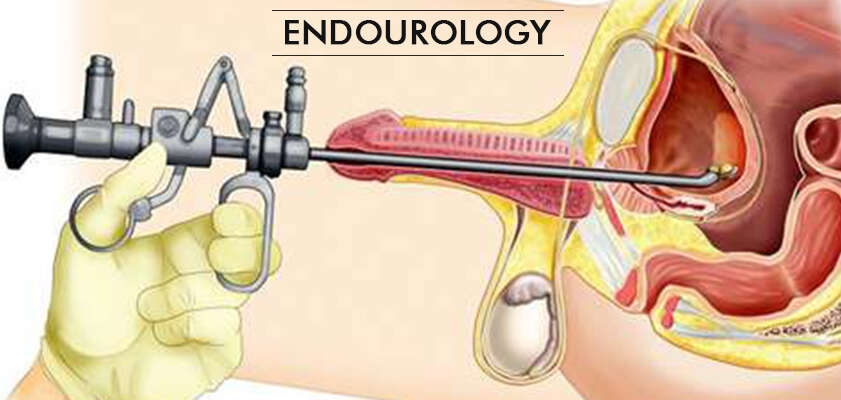Endourology
Endourology is a branch of urology that focuses on the diagnosis and treatment of urinary tract and kidney disorders using minimally invasive techniques. It involves using endoscopes and specialized instruments to access and treat the urinary system without making large incisions. Common procedures performed in endourology include kidney stone removal, ureteral stenting, bladder tumor resection, and prostate surgery.
Compared to traditional urological procedures, Endourological procedures are less invasive. Endourological procedures include:
- Urethroscopy – Urethroscopy is a type of endourological procedure that involves the insertion of a thin tube with a camera (urethroscope) into the urethra to visualize and diagnose conditions affecting the urethra. It allows for a detailed examination of the urethral lining, detection of abnormalities or strictures, and can assist in guiding treatment interventions such as urethral dilation or the removal of small urethral stones or growths. Urethroscopy is a minimally invasive technique that helps urologists evaluate and manage various urethral disorders.
- Cystoscopy –
 Cystoscopy is a common endourological procedure that involves the insertion of a cystoscope—a thin tube with a camera—into the urethra and bladder to visually examine the urinary tract. It allows for the direct visualization of the bladder lining and urethra, helping urologists diagnose and treat various conditions. Cystoscopy can aid in identifying bladder tumors, urinary tract infections, bladder stones, urethral strictures, and other abnormalities. Additionally, during cystoscopy, minor procedures such as bladder biopsy, stone removal, or the placement of a ureteral stent can be performed. It is a minimally invasive technique that provides valuable information for urological evaluation and treatment planning.
Cystoscopy is a common endourological procedure that involves the insertion of a cystoscope—a thin tube with a camera—into the urethra and bladder to visually examine the urinary tract. It allows for the direct visualization of the bladder lining and urethra, helping urologists diagnose and treat various conditions. Cystoscopy can aid in identifying bladder tumors, urinary tract infections, bladder stones, urethral strictures, and other abnormalities. Additionally, during cystoscopy, minor procedures such as bladder biopsy, stone removal, or the placement of a ureteral stent can be performed. It is a minimally invasive technique that provides valuable information for urological evaluation and treatment planning. - Ureteroscopy – Ureteroscopy is an endourological procedure that involves the use of a ureteroscope—a thin, flexible tube with a camera—to examine and treat conditions in the ureter and kidney. It is commonly used for diagnosing and treating kidney stones, ureteral strictures, tumors, and other abnormalities. During ureteroscopy, the ureteroscope is passed through the urethra, bladder, and into the ureter, allowing the urologist to visualize the entire length of the ureter and even the renal pelvis. Ureteroscopy can be combined with various interventions, such as laser lithotripsy to break up and remove kidney stones, or the placement of a ureteral stent to relieve obstruction. This minimally invasive procedure helps urologists diagnose and manage conditions affecting the urinary tract with precision and minimal discomfort to the patient.
- Nephroscopy – Nephroscopy is an endourological procedure that involves the insertion of a nephroscope—a specialized instrument with a camera—into the kidney to visualize and treat conditions within the renal pelvis and kidney.
 It is primarily used for diagnosing and managing kidney stones, tumors, strictures, or other abnormalities within the kidney. Nephroscopy is typically performed through a small incision in the back, allowing the nephroscope to be directed into the kidney. The procedure provides direct visualization of the renal structures, enabling urologists to perform interventions such as stone removal, tumor resection, or placement of a drainage tube. Nephroscopy is a minimally invasive technique that allows for targeted treatment within the kidney, leading to improved outcomes and faster recovery compared to traditional open surgery.
It is primarily used for diagnosing and managing kidney stones, tumors, strictures, or other abnormalities within the kidney. Nephroscopy is typically performed through a small incision in the back, allowing the nephroscope to be directed into the kidney. The procedure provides direct visualization of the renal structures, enabling urologists to perform interventions such as stone removal, tumor resection, or placement of a drainage tube. Nephroscopy is a minimally invasive technique that allows for targeted treatment within the kidney, leading to improved outcomes and faster recovery compared to traditional open surgery.
Dr. Sandip is expertised in following procedures
- PCNL (Endosurgery for Kidney Stones)
- RIRS (Laser Surgery for Kidney Stones and Upper Ureteric Stones using Flexible Ureteroscope)
- ECIRS (Complex Laser Surgery for Kidney Stones using Flexible Ureteroscope)
- URSL (Endourological Procedure for Ureteric Stones)
- PUCLT/PCCLT (Endosurgery for Urinary Bladder Stones)
- TURP (Microsurgery for Prostate)
- TURBT (Microsurgery for Urinary Bladder Tumour)
- HOLEP (Laser Microsurgery for Prostate)
- CPE (Cystopanendoscopy or Cystoscopy: Endourological Procedure to diagnose Urethral and Urinary Bladder Pathology)
- OIU (Endourological Procedure for Stricture Urethra)
- Posterior Urethral Valve Fulgeration
- Ureterocele Incision
- Proximal Urinary Diversion Procedures (DJ Stenting, Suprapubic Cystostomy, Percutaneous Nephrostomy)

